Battle Kimchi! at Yakitori Bar
I love kimchi. But that wasn’t always the case. I never used to be able to stand the stuff until a trip to Seoul in 2006 changed my perspective and I realized that I've been eating such crappy stuff, it didn't deserve to be called kimchi. In Seoul, I was introduced to “real” kimchi—the good stuff that Korean ahjummas lovingly make on a regular basis, secret recipes passed down from generations ago. I also had a chance to attend a kimchi-making class while there and came out with a greater appreciation for this wonderful food afterwards. From that moment, I was instantly converted into a kimchi-lover and have never looked back.
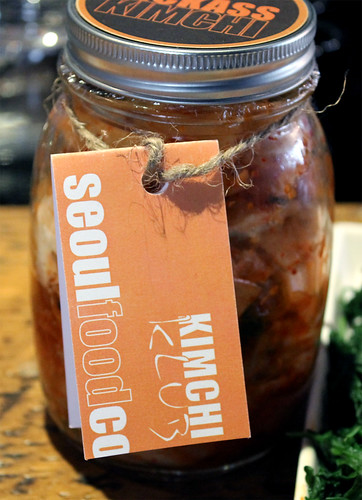
So when I received an invitation to check out a kimchi throwdown, I knew this event was calling my name. On Saturday, February 23, Sang Kim, owner and operator of Seoul Food Co. and Yakitori Bar hosted the first ever Battle Kimchi. Six contestants were culled from the vast Korean community to present their secret kimchi family recipes to an eager crowd and a panel of judges. The prize—the winner will have their kimchi available for sale at Seoul Food Co., alongside Sang’s own Kick Ass Kimchi, starting in March.
When I arrived and saw the various kimchi laid out on the tables, I knew this was serious stuff, and I was in for some seriously good kimchi. Like anything that concerns taste, there is no right criteria that makes an exceptional kimchi—it all depends on personal preference. For Sang, he likes a kimchi that’s robust, fiery, and savoury. For myself, I like a kimchi that has a richer, more pungent flavour (which comes with a longer fermentation process—the kimchi I buy from the Korean supermarket I usually let ferment for at least another week to increase the flavour profile), and that has a right balance of saltiness and acidity, and just a tiny bit of sugar to help round out the flavours (but not enough to actually taste it).

No kimchi will ever taste alike, as so much goes on in the fermentation process and so many factors can affect the flavours (much like when wine ferments, or really anything that requires fermentation). In Korea, there are hundreds of varities and variations of kimchi, a lot of them region-specific and season-specific. The most common variety you’ll find at any Korean restaurant and most Korean tables is the spicy baechu kimchi—made with napa cabbage. Most variations will include daikon, although I've seen some variations that use Asian pears instead. The savoury component often comes from a seafood component, like the more commonly used saeujeot (salted shrimps) or aekjeot (salted anchovy sauce, a Korean fish sauce of sorts). Green onions, ginger, garlic, and of course, gochugaru (Korean chilli pepper), are a staple. I also really like the ggakdugi variety (daikon), and the milder and refreshing baek (white kimchi, with no chilli peppers added) and dongchimi (water kimchi) varieties.

Kimchi #1 – Kim Sun Mi Ms. Kim brought a traditional baechu kimchi, which had a lovely balance of saltiness and acidity. I especially loved the application of her kimchi in the pajeon, which I’ve sometimes done with some ripe kimchi. What made hers so special was that it was made with mung beans, which gave it a wonderful texture—the perfect denseness—and a delightful nuttiness to the flavour profile. The pajeon was topped with some melted cheese.

Kimchi #2 – Rebekka Hutton, Alchemy Pickle Company Rebekka of Alchemy Pickle Company was the only one who brought a daikon kimchi. Her daikon was cut into smaller cubes than what I’m used to finding at the Korean supermarkets, but that meant it allowed the flavours to penetrate right into the center of each piece in a shorter amount of time (one week fermentation), yet still retain its crunchy texture. This was very flavourful, with more ginger to it, and a heavy hit of heat. Daikon crostini were also served, with her kimchi sitting on a slice of sourdough baguette and some melted cheese.

Kimchi #3 – Belle Park, Fresh Baechu + Traditional Baechu Ms. Park brought two versions of kimchi—a freshly made batch and one that had been fermenting for one week. I loved both of Ms. Park’s raw kimchis. You could definitely tell the difference in the fresh, as it had a much sweeter quality from the lack of fermentation, and while I don’t tend to gravitate towards sweeter kimchis, this was surprisingly very refreshing and delightful. The addition of Asian pears and chestnuts adds to the sweetness and some depth in texture. But it was Ms. Park’s traditional baechu kimchi, which had fermented for a week, that won me over. It had everything I look for in a good kimchi—the perfect balance of flavours with a good amount of heat, while the cabbage still retained a nice crunch. Ms. Park used her kimchi in a refreshing soba noodle dish, which was also topped with watercress, thinly sliced egg omelette, and nori, and tossed in her own secret sauce. I’m a big fan of tossing noodles with kimchi, as I often do in the summertime for a refreshing bowl of kimchi naengmyun, so instantly fell in love with this application.
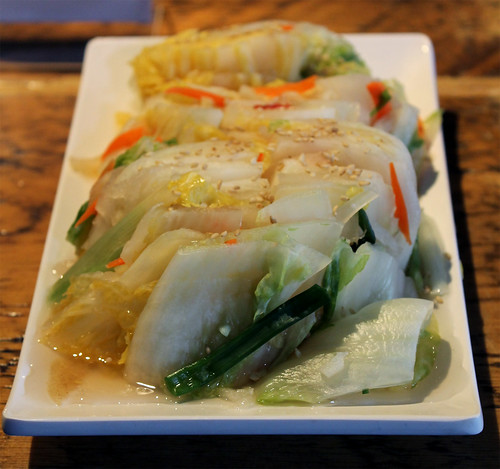
Kimchi #4 – Kathy Kim There was an impressed gasp from the media group earlier in the afternoon when Sang had told us that a UPS package had arrived just that day containing the final kimchi entry—all the way from Vancouver! While Ms. Kim couldn’t grace us with her presence, we were lucky enough to have her kimchi. Her raw kimchi was a baek kimchi—beautifully mild, allowing the natural sweetness of the napa to take centre stage here. A spicy baechu kimchi was used in her application dish, which was turned into a kimchi poutine. Fries and kimchi, need I say more?
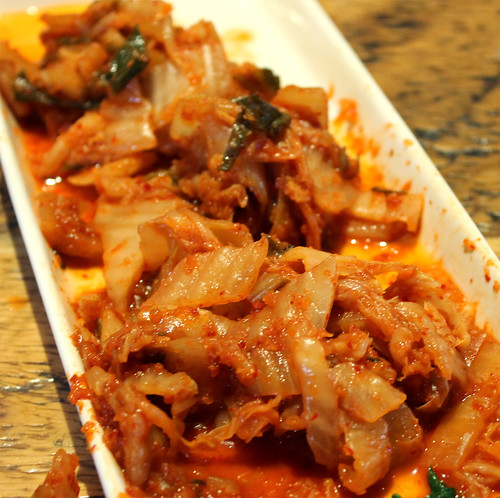
Kimchi #5 – Sang Kim Sang’s Kick Ass Kimchi was the tangiest of the bunch—high acidity note with a slightly sweet finish, and an incredible smoky depth to it. And it’s no wonder, as his kimchi probably had the longest fermentation—about 20 days. For his application dish, Sang served up a quick-cured salmon that had been marinating in his kimchi juice for about two hours.
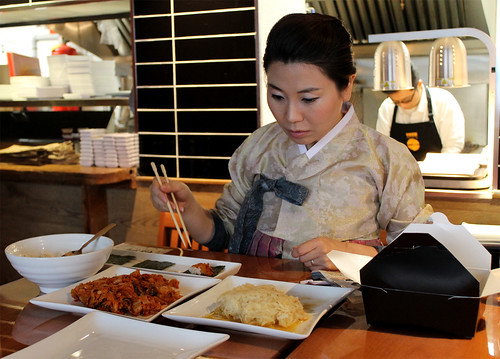
Kimchi #6 – Kim Seung Ah While I was hoping to get a nice kick from all of the kimchi, none of them actually got near to where I was expecting the spice factor to be until I got to Ms. Kim’s kimchi. As I looked at her plate of kimchi—a deep red with every inch of each piece of kimchi covered in chili—I knew this held promise for some fire. And I was rewarded with a super spicy kick. But what I loved most about Ms. Kim’s kimchi was the incredible depth and complexity of flavour that was going on. I can’t quite describe it, but I just felt the different nuances of flavours flicking across my tongue with each chew. Very richly flavoured and well balanced. For her application dish, Ms. Kim made a nori wrap. To take some of the acidity off the kimchi, she rinsed it with some water. Each nori square was topped with some warm rice, some kimchi, and some sauerkraut (or I guess here we can cheekily call it “European kimchi”). It was a simple application, but there was something very comforting about it.
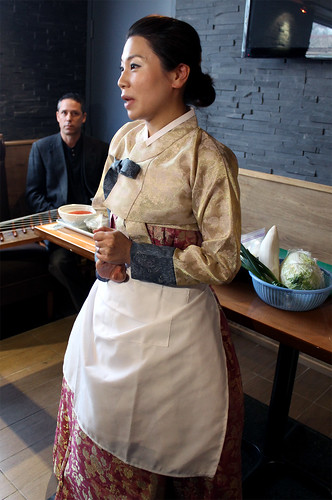
In between all the tasting and photo-opts was a gayageum performance, followed by a story by the incredibly charming Kim Seung Ah, who is a professional storyteller in South Korea (and who wore an absolutely gorgeous hanbok), and a kimchi-making demo.
All of the kimchis were wonderful. While 25% of the vote would come from the people’s choice, the majority of the decision lay with the judges, who were doing a blind tasting of the raw kimchis and their applications. After much discussing and waiting, we finally had a winner. Ms. Belle Park, with her two raw variations and the super delicious soba noodle application.
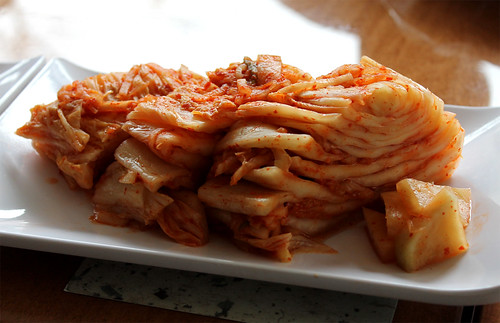
If there’s one more reason to eat (and love) kimchi, it’s that it’s one of the healthiest foods in the world, despite its high sodium level. Through the fermentation process, the bacteria lactobacillus—similar to the bacteria found in yogurt (think probiotics!)—becomes present, which helps with digestion. Kimchi is also high in fiber, low in calories, fat and sugar, and rich in vitamins A and C, calcium, iron, and carotene, among other benefits. Super food? That’s up for you to decide. All I know is that it’s super delicious!
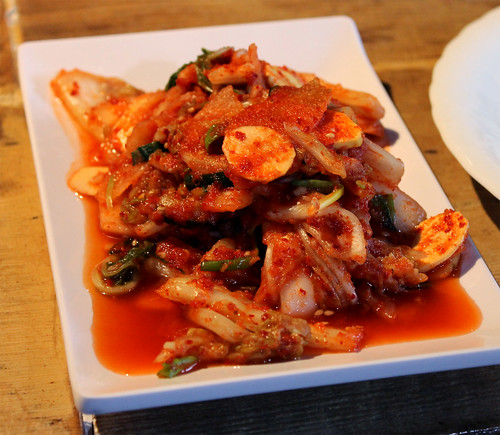
Kimchi has honestly become one of my favourite foods over the last few years, and I always ensure there’s a container of it sitting in my fridge. Avoid the mass-produced stuff. I quite like the stuff from Galleria Supermarket (found in the fresh banchan section of the store). Whether I’m enjoying kimchi on its own, or in a cold noodle dish in the heat of summer, or simply wrapped in a some lettuce and rice with whatever leftover meat I have in the fridge, that salty, tangy, pungent, crunchy bite always hits the spot. When that kimchi has really been fermenting in my fridge and is a little too ripe to eat on its own, I love to use it for kimchi jigae (I personaly find the stew is much more flavourful using old kimchi) or the go-to kimchi fried rice (don’t forget the fried egg!). And it’s not like you can’t eat that ripe kimchi—it’s all just personal preference. That effervescence you get just means there’s a higher level of lactic acid in the kimchi due to the longer fermentation. Well-fermented kimchi actually has a higher level of lactic acid than yogurt. So skip that morning yogurt and do what the Koreans do—eat kimchi for breakfast!

A big, big thank you to the ever so gracious host, Sang Kim, and to Mary Luz Meija and Mario Stojanac of Sizzling Communications for putting together such a delightful event, and bringing together some of the finest kimchi makers in Canada. I can’t wait to see what future Battle Kimchi events will have in store!
Be sure to check back on Wednesday for a recap of the Battle Kimchi 5-course prix fixe menu! You can purchase Ms. Belle Park's winning kimchi starting in March at Seoul Food Co.
Yakitori Bar & Seoul Food Co.
1 Baldwin Street
Toronto, ON
Tel: 647-748-0083
Twitter: @YakitoriToronto







2 comments:
Bonita, as always, wonderful writing, fab photos. Thank you...
Thank you for the lovely writing about Kimchi battle. It was so nice meeting you there. You really knows and loves Kimchi! I hope I can share more stories about Korea with more people.
Post a Comment